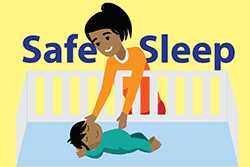October is SIDS Awareness Month

Many parents may have heard about sudden infant death syndrome, or SIDS, and want more information about how to reduce the risk to their babies. About 3,700 infants died of SIDS or other sleep-related causes in the US in 2015. In honor of SIDS Awareness month, we’re sharing tips parents and caregivers can use to help reduce the risk of SIDS and other sleep-related causes of infant death.
How to Create a Safe Sleep Environment
CDC supports the 2016 recommendations issued by the American Academy of Pediatrics (AAP) to reduce the risk of all sleep-related infant deaths, including SIDS. See How to Keep Your Sleeping Baby Safe: AAP Policy Explained to learn more about these and other actions.
1. Place your baby on his or her back for all sleep times—for naps and at night. Some parents may be concerned that a baby who sleeps on his or her back will choke if he or she spits up during sleep. However, babies’ anatomy and gag reflex will prevent them from choking while sleeping on their backs. Babies who sleep on their backs are much less likely to die of SIDS than babies who sleep on their sides or stomachs.

Place your baby on his or her back for all sleep times—for naps and at night.
2. Use a firm sleep surface, such as a mattress in a safety-approved crib or bassinet, covered only by a fitted sheet. Some parents might feel like they should place their baby on a soft surface, such as memory foam, to help him or her to be more comfortable while sleeping. However, soft surfaces can increase the risk of sleep-related death. A firm sleep surface helps reduce the risk of SIDS and suffocation.
3. Have the baby share your room, not your bed. Your baby should not sleep in an adult bed, on a couch, or on a chair alone, with you, or with anyone else. Some parents may feel like they should share their bed with their baby to help them feel more connected. However, accidental suffocation, strangulation, and wedging (for example, being stuck between two objects such as a mattress and a wall) can happen when a baby is sleeping in an adult bed or other unsafe sleep surfaces. Room sharing is much safer than bed sharing and may decrease the risk of SIDS by as much as 50%.
4. Keep soft objects, such as pillows and loose bedding out of your baby’s sleep area. Some parents may feel they should add soft objects to their baby’s crib to help keep their baby warm and comfortable while sleeping. However, soft objects and loose bedding, like stuffed toys, sheets, comforters, and blankets, can increase the risk of suffocation and other sleep-related deaths. If you’re worried about your baby getting cold during sleep, you can dress her or him in sleep clothing (like a wearable blanket) to keep your baby warm.
5. Do not allow smoking around your baby. Smoke in the baby’s surroundings is a major risk factor for SIDS. Quitting smoking can be hard, but it is one of the best ways parents and caregivers can protect their health and their baby’s health. For help in quitting, call the quitline at 1-800-QUIT-NOW (1-800-784-8669) or visit smokefree.gov.
CDC’s SUID and SIDS Activities
Sudden unexpected infant death (SUID) is the sudden and unexpected death of an infant less than 1 year old without an obvious cause of death before investigation. Most SUIDs are reported as one of three types: SIDS, unknown causes, or accidental suffocation and strangulation in bed. CDC’s Division of Reproductive Health (DRH) provides scientific leadership in SUID by presenting the most up-to-date information about SUID rates and risk factors in peer-reviewed publications. CDC scientists recently authored the first study examining racial and ethnic trends in SUID in the U.S., and found that while the SUID rate has declined since 1994, significant racial and ethnic differences continue to exist. CDC’s DRH also has SUID monitoring programs in 16 states and 2 jurisdictions, covering about 30% of all SUID cases in the United States. Participating states and jurisdictions use data about SUID trends and circumstances to develop strategies to reduce future deaths. Learn more about CDC resources, publications, and activities to address SUID and SIDS.
More Information
Reducing the Risk
- Parents and Caregivers
- Reduce the Risk of SIDS & Suffocation
- Ways To Reduce the Risk of SIDS and Other Sleep-Related Causes of Infant Death
Grief Resources
- Page last reviewed: October 2, 2017
- Page last updated: October 2, 2017
- Content source:
- National Center for Chronic Disease Prevention and Health Promotion, Division of Reproductive Health
- Page maintained by: Office of the Associate Director for Communication, Digital Media Branch, Division of Public Affairs




 ShareCompartir
ShareCompartir